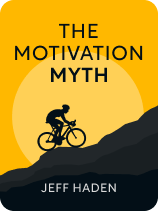

This article is an excerpt from the Shortform book guide to "The Motivation Myth" by Jeff Haden. Shortform has the world's best summaries and analyses of books you should be reading.
Like this article? Sign up for a free trial here.
What is The Motivation Myth book about? Is there something you’ve dreamed of doing, but thought you’d never achieve it?
In The Motivation Myth, Jeff Haden argues that you shouldn’t wait for motivation to start you down the road to success. Instead, you should make your own motivation by creating a plan, celebrating every win, and persevering through disappointments.
Read below for a brief overview of The Motivation Myth.
The Motivation Myth by Jeff Haden
Do you have goals and ambitions that you can never seem to get off the ground? Are you waiting for a spark of motivation to finally get yourself moving? If so, then you’re going about it all wrong. According to Jeff Haden, motivation comes after achievement, not before. It’s only once you’ve started down the road to your dreams that you can create the motivation to keep yourself going.
In The Motivation Myth book, published in 2018, Haden explains how to build up motivation as a product of success and use it to push you toward even greater achievements. He argues that your lofty goals should only provide a direction for the path you want to take in life and that true motivation comes from learning to take pride in every inch of incremental progress you make. Instead of waiting to bask in the glow of achieving your ambitions in the distant future, you can create the motivation you need for success by celebrating every step along the way.
Haden began his career in the manufacturing industry before becoming a regular columnist for Inc. Magazine, a LinkedIn influencer, and the ghostwriter of numerous best-selling books. He is known for his public speaking on entrepreneurship and personal growth, as well as for being a physical fitness enthusiast, from which he draws on personal experience for his knowledge of how to motivate yourself.
Preparation
The first step toward reaching your goals isn’t finding motivation. To begin, you must first design a program that will help you build the momentum you’ll need to accomplish your objectives. In this section, we’ll cover Haden’s advice about finding a professional example on which to model your program for success and creating a routine that will kickstart you into action.
The hardest part of following a course of action is starting in the first place. Haden says that once you get over that initial hump, it’s much easier to keep moving toward your goal. What’s holding you back isn’t a lack of motivation, but rather a lack of preparation. Preparation gives you enough confidence to help you cross your first hurdles, after which, incremental success will slowly grow your motivation to keep going.
When starting out, don’t focus on the end goal, whether that’s earning a college degree, winning a swimming competition, or writing a best-selling novel. Instead, try to imagine how good it will feel once you’ve got the ball rolling. Keep your mind on the next step toward your goal and the feeling of accomplishment your next small win will bring.
You should be careful, though, not to celebrate too soon. Haden writes that this usually happens when you let others know what you hope to achieve. With the intention of being supportive, they’ll often congratulate you in advance, which will simulate the feeling that you’ve already reached your goal. But the feeling that you’ve won the race before it’s started is nothing but an illusion, and people who experience it are less likely to follow through on the work needed to achieve real success. Instead of telling your friends what you wish to accomplish, talk about the steps you’ll take to get there. To do that, you’ll need to know what those steps are.
Find a Teacher
To design your path to success, Haden suggests finding a high-achieving professional to emulate. Study how they achieved what you’re after, and determine the steps they took along the way. Haden stresses the difference between a professional and a coach, gives clues as to how to emulate their path to accomplishment, and suggests ways to place yourself in the right surroundings to gain access to a variety of professionals to learn from.
Haden recommends using a professional, not a coach, as a model because, unlike a coach, a professional won’t cheer you on or cut you any slack. A professional who isn’t a mentor by trade will simply explain what it takes to succeed and expect you to do it. The trick is to channel their experience and techniques. Once you’ve identified a person to emulate, you don’t even have to meet them in real life—just pick someone whose path you want to mirror, and do what they did without taking shortcuts. It’s not actually the person themself that you need but the program for success that they used.
Haden says to start by picking one thing your professional exemplar does that would point you toward your goal, then do it even if it seems to go against your normal behavior. If they’re a novelist, perhaps they wake up hours before you do to write while everyone else is asleep. If they’re a top-ranked public speaker, maybe they do vocal warmups every morning as part of their exercise routine. Whatever activity you select will stretch you in ways you aren’t accustomed to and will grow your skills in ways you might not have expected.
Build Your Program
Haden says the true purpose of designing a program is so that you can stop worrying about your goals at all. Instead, a good program will let you laser-focus on your next step and nothing else. Here, we’ll discuss how to choose a program to follow and how establishing a routine eliminates the need for willpower. We’ll also cover tips for how to maintain your focus.
Thankfully, when plotting your course, you don’t have to reinvent the wheel or rediscover fire. Chances are that whatever you aspire to, whether it’s to paint professional-level murals or to kayak down Class V rapids, someone else has already achieved it and mapped out a program to get there. You merely have to do your research and choose from the many different programs available. Haden suggests that you shouldn’t waste time fretting over which program is the most ideal for you because you have no way of knowing until you’ve started. The advantage of any good program toward success is that it lays out every step you need to take, saving you the time and effort of figuring it out for yourself.
The next vital component is to turn your program into a routine. By making your efforts toward your goal automatic, a routine negates the need for motivation. Without a routine, every day and moment means you must consciously choose whether to follow your program or do something else, such as binge-watch TV or play games on your phone. Having to make that choice depletes your will and makes it more likely that you won’t follow through. However, if you establish a routine that keeps you on your program, you’ll no longer have to decide what to do. Followed long enough, a routine makes the steps toward your goal a part of your identity—it’s not just what you do, it’s who you are.
Establishing a routine is easier said than done. Haden offers several tips to make it less of an uphill battle:
- Redesign your workspace to eliminate distractions (such as putting away your phone and closing your door so you won’t be interrupted).
- Place reminders of your overall goal, such as sticky notes and photos, in places where they’ll interrupt temptations (such as on your refrigerator or in front of your TV).
- Keep healthy snacks easily available (such as fruits, vegetables, or nuts) to keep your energy levels from flagging.
- At the end of each day, plan out the next one, so you won’t have to spend that energy in the morning. Use that start-of-day energy instead to tackle your hardest task first.
Repetition
Since motivation isn’t what starts you down the road to success, what role does it actually play? According to Haden, motivation is momentum that keeps your program of improvement moving forward through a repeating, self-energizing cycle. In this section, we’ll talk about how that cycle works, how repetition reduces luck as a factor in your success, and how it provides you with steady, regular feedback that you can use to adjust your program going forward.
The path to achievement is a slow and steady process that requires putting your nose to the grindstone and doing the work, day after day. That’s disheartening if you’re focused on your goal, such as getting a million YouTube subscribers or growing the prettiest garden on your street, because especially in the early days, your goal will seem a million miles away. Instead, you should focus on individual steps, celebrating each bit of incremental progress. Haden writes that every small victory triggers a response in your brain’s reward center that sets up a positive feedback loop, which will push you to take the next step, and the next. There’s the motivation you’ve been lacking—not at the start of the process, but in the middle.
And now a word of caution: Hard work and repetition don’t guarantee success, but they do improve your probability of success. More than that, Haden explains that if you stick with your program long enough, you’ll be able to calculate the odds of your efforts paying off in a way that will tell you how much work you have left to do. For example, if you’ve been job-hunting for some time, you may find that one in every ten applications results in a call-back from a potential employer. Therefore, if you’d like a call-back every day, that tells you how many jobs to apply for. Random chance is still a factor, but if you act as if your success is completely under your control, you can minimize your reliance on luck just through simple mathematics.
Resilience
Even with the motivation cycle that comes from repetition and incremental improvement, that by itself may not be enough to keep you going. Therefore, it’s important to develop resilience, which Haden defines as the ability to persevere through difficulties and disappointments. Such resilience doesn’t come from being stronger, smarter, or more energetic but from learning to make the most effective use of the abilities you already have. Haden gives two specific suggestions for efficiently using your time and energy, which we’ll cover in a moment:
- Conserve your resources by saying no to things that distract from your goal.
- Dedicate an entire day to focusing your efforts on one specific task.
In general, though, resilience (like motivation) is a mental construct that arises from making a deliberate choice to ignore distractions and focus on your goal.
Success
Suppose you’ve done everything that Haden’s recommended. You’ve created a program for success and followed it, celebrated every improvement you’ve made, and learned to endure all the bumps and roadblocks. How do you know when you’ve finally “made it,” and what do you do next if you find the success you’ve been after?
Defining what success means for you is crucial to living a balanced, healthy life. Haden offers guidelines on how to realistically measure success, why you should aim for it in multiple parts of your life, and why personal goals should be just as important, if not more important, than professional ones.
He begins by pointing out that any goal you pursue comes with a cost. Chasing professional goals will often mean neglecting the rest of your life while devoting yourself to personal goals will usually mean not making the most of your career. Therefore, Haden says it’s unrealistic to believe that you can maximize both. Instead, you need to be honest with yourself about how you define “good enough.” If you wish to be among the top 1% in any field, whether that’s sales, photography, or weightlifting, it will take a lifetime of single-minded dedication. However, being counted in the top 10% is eminently rewarding and much more achievable.
With that in mind, Haden lays out the following rules:
1. Before setting out on an ambitious project, make sure that you’re mentally, physically, and financially sound. If you can’t meet your basic human needs of food, shelter, community, and relationships, then that’s what you have to take care of first.
2. When you set a long-term goal, choose one that fulfills you in more than one aspect of your life. It’s easy to give up on goals that only serve one facet of yourself, such as your job or your health. A goal that brings together more than one ambition—such as becoming a freelance writer to further your career and your creative drive—will be more closely tied to your identity and less likely to get dropped by the wayside.
3. Define your goal in a way that’s quantifiable. Your ambition can start as a nebulous dream, but as you set your course it should grow more concrete. Quantifiable goals let you know if you’ve achieved them—you’ll know for certain when you’ve finished hiking the Appalachian Trail, just as you’ll know you’ve scored an acting role in the latest television sitcom. Solid goals are based on more than just a feeling.

———End of Preview———
Like what you just read? Read the rest of the world's best book summary and analysis of Jeff Haden's "The Motivation Myth" at Shortform.
Here's what you'll find in our full The Motivation Myth summary:
- Why you should stop waiting for motivation to hit and instead, make your own
- How to create a cycle of positive reinforcement to boost your motivation
- How to develop resilience to get through times of struggle






